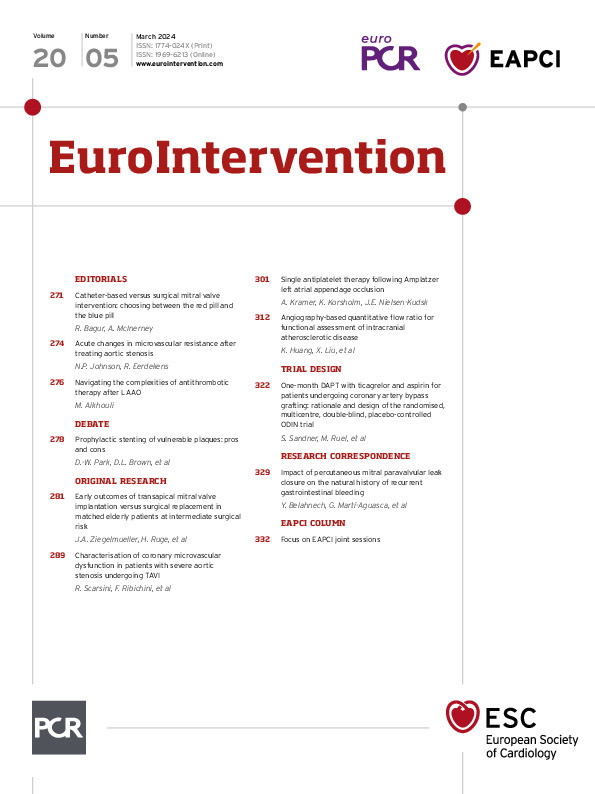Left atrial appendage occlusion (LAAO) is a promising stroke prevention strategy for atrial fibrillation patients who are intolerant to oral anticoagulants (OAC)1. Although the premise of LAAO is to replace OAC, a brief course of antithrombotic therapy is recommended post-procedure to mitigate the risk of device-related thrombus (DRT). However, the optimal duration and regimen of antithrombotic therapy remain unclear, leading to diverse practices and continuous debate. Indeed, studies supporting specific antithrombotic regimens after LAAO included heteroÂgeneous populations treated with various devices, and these yielded conflicting results23.
In this issue of EuroIntervention, Kramer et al sought to assess the long-term outcomes of an appealing but infrequently utilised antithrombotic strategy after LAAO: single antiplatelet therapy (SAPT)4. Their study included 553 patients who underwent LAAO using an Amplatzer device (Abbott) between 2010 and 2021, of whom 78% were prescribed SAPT post-LAAO. The primary endpoint was the presence of DRT on imaging at 6 to 12 weeks. Other outcomes included mortality, stroke, and major bleeding (Bleeding Academic Research Consortium Type ≥2). Short-term data were obtained from a well-maintained institutional registry, while long-term outcomes were extracted from Danish national health registries. Outcomes were reported both for patients treated with SAPT and for those treated with a non-SAPT regimen. The median follow-up duration for the SAPT cohort was ~4 years.
Imaging was performed in 413/431 of patients discharged on SAPT (computed tomography [CT] in 94% and transÂoesophageal echocardiography [TOE] in 6%). Five patients (1.5%) had DRT during early imaging (4 on CT and 1 on TOE), and 18 patients (4.7%) had low-grade hypoattenuation thickening (HAT). Among patients discharged on non-SAPT antithrombotic regimens, the incidence of DRT was 2.7%. Notably, 42% and 48% of patients in the SAPT cohort were on no antithrombotic therapy at 6 and 12 months, respectively. During the 4-year follow-up period, 33 patients (7.7%) experienced an ischaemic stroke, 40 (9.3%) had a major bleed, and 111 (25.7%) died, corresponding to 4-year cumulative incidence rates of 8.4%, 9.7%, and 28.3%, respectively. There were no statistically significant differences in clinical events between the SAPT and non-SAPT cohorts. The authors concluded that the use of SAPT after LAAO with the Amplatzer device is safe and effective, arguing that it was associated with comparable rates of DRT and stroke to those reported in large registries when utilising non-SAPT regimens.
The study has several strengths, including the liberal use of SAPT (78% of patients), minimal missing data, and the near-universal use of CT for post-LAAO surveillance. Nonetheless, there are several key aspects that warrant further examination:
1. Interpreting the study’s findings necessitates the consideration of the major uncertainties in the field. It is important to recognise that our current approaches to post-LAAO antithrombotic therapy are primarily empirical, lacking a foundation in robust translational science. Crucial elements such as the mechanics, timing, and extent of endothelialisation, as well as the underlying mechanisms of DRT, remain elusive and are the subjects of ongoing research56.
2. Despite incorporating a non-SAPT arm (n=122), the study’s constrained statistical power limits its comparative analysis between the two groups. Therefore, its results should be viewed as hypothesis-generating rather than definitive proof of the superiority of SAPT as an antithrombotic treatment post-LAAO.
3. The decision to focus on an imaging finding (namely DRT) over clinical events as the primary endpoint might invite critique. However, this approach is justified considering the small sample size and the access to high-quality CT imaging data. Future research should include periodic CT imaging (6- or 12-month intervals) and delve deeper into the implications of HAT, especially considering its frequent occurrence and uncertain progression.
4. Both Amplatzer Amulet (Abbott) and WATCHMAN FLX (Boston Scientific) devices have U.S. Food and Drug Administration (FDA)-approved OAC-free antithrombotic protocols, yet these protocols necessitate dual antiplatelet therapy (45 days for WATCHMAN FLX and 6 months for Amulet). The absence of an approved SAPT regimen for these devices underscores the unmet clinical needs and the innovative aspect of this study.
5. The primary advantage of single over dual antiplatelet therapy is the reduced risk of bleeding. Yet, about 10% of the SAPT group experienced major bleeding, even though nearly half discontinued SAPT after 1 year. This unexpectedly high bleeding rate, potentially influenced by International Classification of Diseases, tenth revision, (ICD-10) coding discrepancies, warrants further study to ascertain the true benefits of a SAPT regimen.
6. The annualised rate of stroke post-LAAO was >2% which emphasises the high residual risk of stroke in this population. It remains unknown whether these strokes were related to delayed DRT not seen on initial imaging or whether they resulted from other factors not related to LAAO7. Regardless, more research is needed to address the non-negligible remaining stroke risk post-LAAO.
7. The high mortality in this study (nearly 30% at 4 years) raises some concerns about the futility of LAAO and suggests the need for judicious use of this preventative procedure.
Kramer et al deserve recognition for their diligent work on a challenging subject. Their findings provide valuable insights but also highlight numerous unresolved questions, emphasising the need for ongoing research to maintain and enhance the success of LAAO.
Conflict of interest statement
M. Alkhouli is on the advisory board for Abbott and Boston Scientific.

